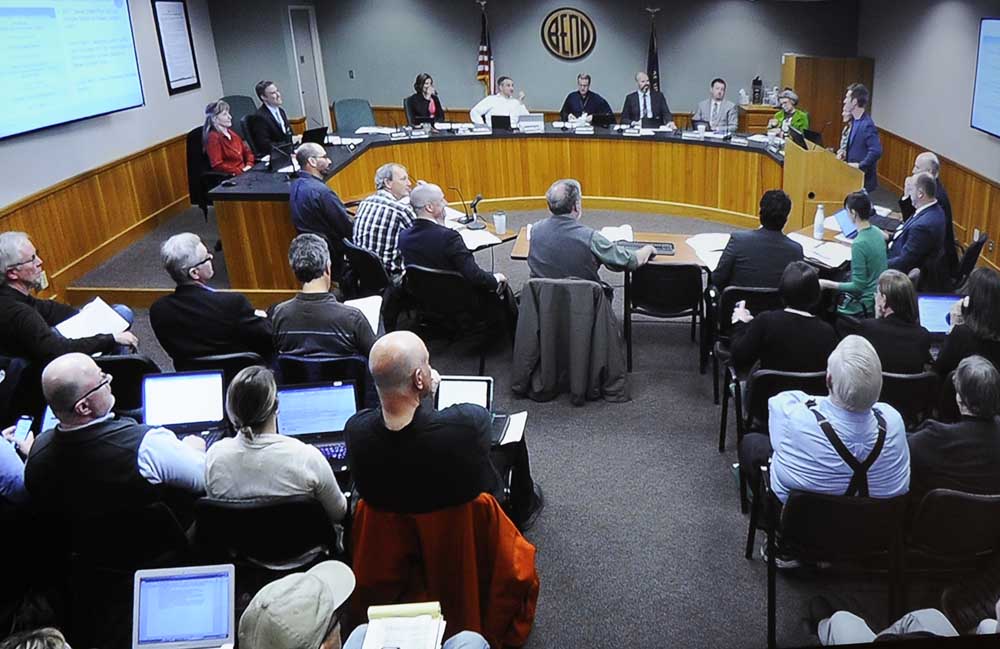Center of Bend, southeast ‘elbow’ prime spots for development
Published 12:00 am Thursday, March 22, 2018

- A Bend City Council meeting in March 2018.(Ryan Brennecke/Bulletin photo)
Redeveloping areas in the middle of Bend and building in an elbow-shaped area just outside of city limits in southeast Bend are the two simplest, fastest ways to add more homes and jobs, city employees and consultants told the Bend City Council on Wednesday.
The city of Bend has been looking at how best to develop and annex about 2,380 acres outside city limits and build taller, denser buildings in some areas in Bend. Areas that don’t require extensive sewer and road work can be ready sooner than others, said Jon Skidmore, assistant city manager.
Trending
“We’re all familiar with the old adage ‘Rome wasn’t built in a day,’” Skidmore said. “Bend won’t be either.”
Areas outside city limits on the very north end of town and in the northeast could add more than 2,000 new jobs and nearly 1,500 homes by 2028, according to the city, but they’ll be more difficult to develop.
Both areas would need the city to finish expensive sewer lines, as well as between $50 million and $71 million in mostly new roads.
The elbow-shaped area could add more than 2,200 jobs and more than 800 homes by 2028, and most of its sewer needs are covered by the major sewer line the city completed earlier this year, said Brian Rankin, Bend planning manager. It would take nearly $70 million in road construction.
“It’s one of the most ready areas, certainly the most-ready expansion area,” Rankin said.
Developing the core areas in Bend will cost the least, Rankin said. Sewer and water infrastructure is there, and about $27 million in roadwork would consist of improving existing roads.
Trending
Different tools would work better to spur redevelopment in some parts of Bend than others, consultants said. The Bend Central District, a 206-acre area that extends south from Revere Avenue to railroad tracks between the parkway and Fourth Street, and some surrounding areas, are good contenders for urban renewal, said Lorelei Juntunen, project director at ECONorthwest, an economic consulting firm.
Urban renewal areas are designated parts of town where cities invest in new infrastructure or other improvements and use expected tax revenue to pay for it through a process called tax increment financing. Individual taxpayers pay what they would without an urban renewal area, but the amount cities can spend on services like police and fire is capped.
A coalition of landowners, businesses, neighborhood associations and nonprofits sent councilors a letter last week asking them to consider urban renewal in the central district. Tax increment financing there could be used to improve roads and make them safer for bicyclists and pedestrians and invest in affordable housing, Juntunen said, but it won’t pay for everything.
“It’s not a silver bullet,” she said. “It gets layered in with other financial tools.”
In other parts of town, like the central west-side area, tax breaks for developers of apartment buildings could work better, said Alex Joyce, managing partner of Cascadia Partners. Two tax exemption programs let developers get a short-term break on their property taxes for multistory, multifamily apartments, and they can make these projects financially feasible, Joyce said.
“This is a little nudge to get you what your plan says you want,” he said.
The city also can allow developers of multifamily homes to pay their system development charges — fees intended to cover additional use of city infrastructure — over time instead of paying a large lump sum, he said. Layering those tools would let the city ask developers for concessions such as including affordable apartments, Joyce said.
Councilors will hear comments from residents about growth planning during a regular council meeting on April 4, then vote on priorities on April 18.
— Reporter: 541-633-2160; jshumway@bendbulletin.com








